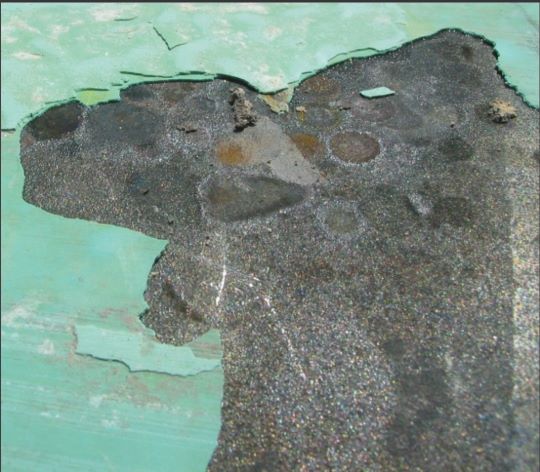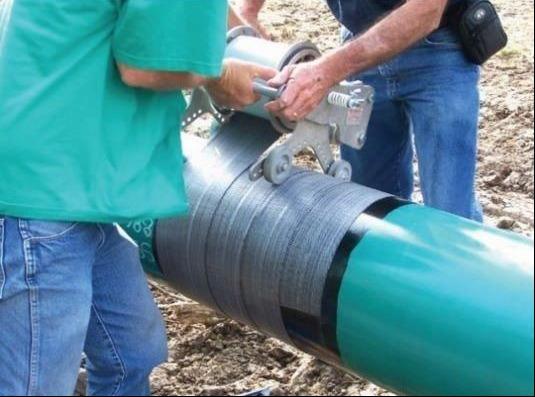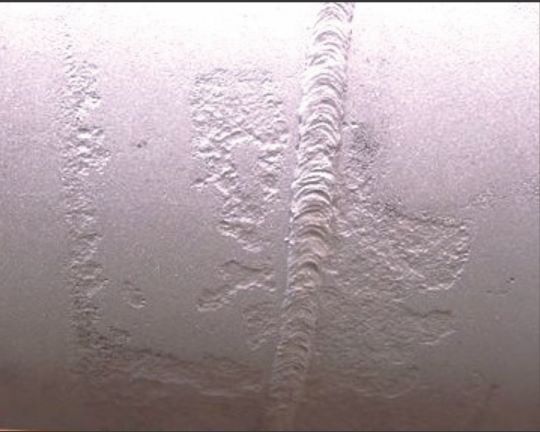Many pipeline companies ignore why external corrosion occurs when cathodic protection (CP) is considered adequate. Understanding the failure mode of the coating and why CP cannot adequately protect the pipe under certain disbonded coating types is critical.1
Choosing coating systems that tend to be non-shielding to cathodic protection (CP) when disbondments occur should be a coating selection criterion. The further development of such coatings systems should be a priority. If there is corrosion because the coating has shielded the cathodic current, then the coating has failed (Figure 1, top).2
External stress corrosion cracking (SCC), corrosion, and bacteria-induced corrosion occur under disbonded, CP-shielding pipeline coatings. Recent major failures in North America once again point out this fact.
Selection Criteria
Every coating type has specific properties that must be thoroughly researched, tested, and understood before it is selected to externally coat pipelines protected by CP.
For CP to effectively protect the pipeline steel, there must be a current path to the steel. All pipeline coatings can fail or lose adhesion for a variety of well documented reasons. All pipeline coatings used with CP must have dielectric strength to control the amount of CP current consumed.
Pipeline Coatings
Pipeline coatings should provide a balance of dielectric strength with nonshielding tendencies if disbondment occurs. Disbonded coatings are coatings that have lost adhesion to the pipe. Fusion-bonded epoxy (FBE) coatings provide an excellent balance of barrier properties to prevent corrosion while simultaneously not shielding the pipeline from the benefits of CP.3
Both high pH and the presences of magnetite film appear to support past work which suggested FBE does not shield CP current.4
Defining Non-Shielding Coatings
NACE SP0169-2013 and the awaited final for the next revision address electrical shielding in multiple sections and suggest prevention and interpretation of shielding scenarios.
Section 4.2.3 states, “Piping systems should be constructed in such a manner to avoid electrical shielding of CP.” Of relevant consideration, Section 6.3.7 says “Reliable measurement of potentials and therefore interpretation of CP criteria can be significantly affected by the presence of electrical shielding.”
NACE Publication 10A392-2006, “Effectiveness of Cathodic Protection on Thermally Insulated Underground Metallic Structures,” says, “Electrical shielding can be caused by disbonded coatings, thermal insulation, loose wrappers, high-resistivity rock or soils, metal structures or pipelines that are close to the structure being protected, and other manmade materials partially or completely surrounding the pipeline.”
Test procedures were developed, but now mainly ignored, to test coatings for shielding and non-shielding tendencies. Hundreds of papers and presentations provide evidence of the non-shielding vs. shielding properties of pipeline coating systems.
Coatings and Cathodic Protection
The AMPP Pipeline Coatings book provides the history, selection, application, and testing of pipeline coatings. Some coatings that incorporate an electrically insulating outer layer, such as polyolefin, solid film-backed tape, shrink sleeves, etc., can preclude effective CP from reaching the pipes’ surface in disbanded areas.5
Most external corrosion on cathodically protected pipelines today is not due to inadequate CP levels but is instead caused by disbonded coatings that shield the CP.6 Many factors go into the coating selection decision, including cost, damage resistance, pipeline terrain, backfill, soil conditions, joint coating solutions, quality assurance, logistics, electrical-resistance stability, non-shielding to CP, pipeline operating temperature, SCC, and lifetime cost, among others.7
Depending Only on CP
None of the CP criteria or even their combinations sufficiently guaranteed adequate protection of a pipeline in all field conditions such as pitting under shielding coating disbonded from the pipe surface.8 Adequate CP has been defined in SP0169, and each revision has more stringent requirements for determining adequate protection.
None of these methods provide a way of determining if there is disbonded, CP-shielding coating. Some pipeline companies have acknowledged this is their number one cause of external corrosion.
Proven Non-Shielding Coatings
There have been many presentations about corrosion found under disbonded CP-shielding coating, such as shrink sleeves, solid film-backed tape, coal tar and others. Any pipeline coating used with CP must have dielectric strength, but it does not have to be CP shielding if a disbondment occurs.
FBE
The NACE book Fusion-Bonded Epoxy (FBE) by J. Alan Kehr addresses this subject. Kehr explains how water is absorbed by FBE coatings. Case histories show where FBE has blistered or disbonded, yet no corrosion occurred when adequate CP was provided.
The pH under the FBE was high, indicating adequate CP was present. This is a property of FBE. It is believed that the high permeability of FBE coating to water is the reason for the apparently “transparent” nature of FBE coating to CP (Figure 2).9

By selecting and using “fail-safe” (non-shielding) pipeline coating systems, the likelihood of reoccurring corrosion and SCC under disbonded coating is significantly reduced or eliminated with adequate CP.10
As with all pipeline coatings, FBE coatings have failed, but in over 60 years, rarely is metal loss found on the pipe when CP is adequate. “If the FBE shielded the pipe from CP current (when disbondments occur), the CP system would not provide much backup corrosion protection, if any,” a 2023 Sherwin-Williams article states.11
Corrosion has been found under disbonded FBE, but this is extremely rare and is usually caused by inadequate CP or shielding from another source.
Unless there are other causes, such as electrical shielding, inadequate CP, or interference, there is rarely corrosion, SCC, or bacteria. This property of FBE allows CP current to raise the pH of the electrolyte under a blister or disbondment.
Mesh-Backed Tapes
Mesh-backed tapes have been used for field repairs, girth welds, and new pipe in various applications since 1988. Unlike the solid film-backed tapes and shrink sleeves, CP shielding has not been an issue (when adequate CP is available) if disbondment or damage occurs. In the rare sites where disbanded mesh-backed tape has occurred, pH of the electrolyte in the disbondment has typically been 8 or above.
When properly applied, the mesh-backed tape will be well bonded and does not have issues with stretching and wrinkling like the solid film-backed tapes and shrink sleeves (Figure 3). Woven glass fiber (now called mesh-backed tape coatings) offer the best overall performance and rating for this category of coating.12 This is a significant difference from solid film-backed tape.

Two-Part Epoxy
Two-part epoxy usually fails by cracking which can allow CP to protect the pipe surface. Much depends on the failure mode of the two-part epoxy. If it blisters, the blisters can crack, allowing CP into the crevice. If disbondments are large (usually because of surface preparation or application issues), then some shielding could occur. Field evaluation and taking pH, etc., will provide the proof needed.
The Proof
Information gathered from hundreds of thousands of miles of in-line inspection (ILI) tools has given the industry a wealth of knowledge about various coatings. Electromagnetic transducer technology (EMAT) can detect the type of coating and whether it is disbonded. The proof is in every properly performed and recorded field evaluation. Some still ignore these facts instead of using them to improve.
Above-ground survey techniques cannot locate or confirm disbonded CP shielding coatings, non-shielding coatings, or if there is corrosion. These surveys can provide locations where current is being consumed and, along with ILI/ EMAT, can effectively find where external corrosion and SCC are present.
“Therefore, it is important to provide information on factors that can lead to SCC. One such factor is coating disbondment,” S. Tappert, et al., wrote in Pipeline and Gas Journal.13
Integrity Management
An integrity management plan must state how the operator will avoid future damage to the pipeline. Valid integrity management plans must describe how the operator will monitor the pipeline to assure that threats to the pipeline have been successfully mitigated or neutralized.
Valid integrity is understanding pipeline coating performance related to CP if there is a disbondment or coating failure. “The formation of disbondment behind a coating that passes CP presents a third ranking. In this case the coating has failed, but CP can act as a backup,” S.S. Papavinasam, M. Attard, and R.W. Revie wrote in a 2006 issue of Materials Performance14 (Figure 4). The integrity question is, does the coating shield CP if the adhesion fails and electrolyte penetrates?

Regulatory Coating Requirements
The minimum coating requirements as stated by the Pipeline and Hazardous Materials Safety Administration (PHMSA), Title 49 Code of Federal Regulations (CFR) for the transportation of natural and other gas at 80 % SMYS, Part 192.112 says, “The pipe must be protected against external corrosion by a non-shielding coating.”
For the transportation of hazardous liquids by pipeline, Part 195.559 says coating materials must “support any supplemental cathodic protection.” How can a coating that shields CP when adhesion fails meet this requirement?
Single layer, non-shielding FBE barrier coating systems offer anti-corrosion protection for underground pipelines, as well as verification of their performance from above ground,” J. Rogozinski wrote in World Pipelines.15 Meshbacked wraps and two-part epoxies have also shown compatibility with CP if there is coating disbondment.
Conclusions
Many types of pipeline coatings have been used for more than 100 years. All coating can disbond or be damaged.
Poor application or inspection, incomplete specifications, improper selection, handling of the coated pipes, soil stress, wrong application procedures, external impacts (rocks, digging equipment, floods, etc.), and many more environmental issues cause all coating types to fail and potentially shield CP leading to external corrosion, bacterial corrosion, and SCC.
To improve integrity for cathodically protected structures, why not develop and use pipeline coatings that tend to be non-shielding when disbondments occur? Proof of coating integrity is critical for all pipelines.
Editor’s note: This article first appeared in the August 2024 print issue of Materials Performance (MP) Magazine. Reprinted with permission.